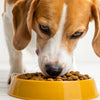Can Adding Water to Dry Dog Food Cause Diarrhea? Unpacking the Impact on Your Dog’s Digestive Health
- Houndsy
Table of Contents
- Introduction
- The Importance of a Balanced Diet for Dogs
- The Science Behind Adding Water to Dry Dog Food
- Practical Tips for Adding Water to Dry Dog Food
- Potential Risks of Adding Water to Dry Dog Food
- Conclusion
Introduction
Did you know that digestive issues, including diarrhea, are among the top concerns for dog owners? In fact, studies suggest that nearly 1 in 10 dogs will experience gastrointestinal upset at some point in their lives. As pet parents, we strive to provide the best for our furry companions, but the question remains: can adding water to dry dog food cause diarrhea? This is a topic that resonates deeply with many of us who want to ensure our dogs enjoy their meals without adverse effects.
In this blog post, we will explore the implications of adding water to dry dog food, examining both the potential benefits and drawbacks. We aim to shed light on how this practice can influence your dog's digestive health, hydration levels, and overall well-being. By the end, you’ll have a clearer understanding of whether adding water to dry dog food is a good choice for your beloved pet.
We will cover the following key aspects:
- The importance of a balanced diet for dogs
- The science behind adding water to dry dog food
- Practical tips for doing so safely
- Potential risks and health concerns associated with this practice
So, let’s delve into the world of canine nutrition and see how we can make mealtime a delightful experience for our dogs!
The Importance of a Balanced Diet for Dogs
Maintaining a balanced diet is crucial for our dogs' overall health. A well-rounded diet provides the necessary nutrients to support growth, energy levels, and immune function. Dry dog food, commonly known as kibble, is a popular choice among pet owners due to its convenience and nutritional formulation.
Key Nutrients in Dog Food
- Proteins: Essential for muscle development and overall health.
- Carbohydrates: Provide energy.
- Fats: Necessary for healthy skin and a shiny coat.
- Vitamins and Minerals: Support various bodily functions and boost immunity.
While kibble is nutritionally complete, some dogs, particularly those with dental issues or older pets, may struggle to chew effectively. This leads many dog owners to consider adding water to soften the kibble, enhancing palatability and making meals easier to consume.
Reflection Point
Have you ever considered how your dog’s eating habits might change with a simple adjustment like adding water? It’s worth reflecting on your pet’s preferences and needs during mealtime.
The Science Behind Adding Water to Dry Dog Food
Adding water to dry dog food can lead to several outcomes, both positive and negative. Here’s a closer look at how this seemingly simple act can affect your dog’s digestive health.
Benefits of Adding Water
- Enhanced Palatability: Water can increase the aroma and flavor of kibble, making it more appealing to picky eaters.
- Improved Hydration: Many dogs don’t drink enough water, and moistening their food can help increase their overall fluid intake.
- Easier Digestion: Soaking kibble can help make it easier for dogs with sensitive stomachs or dental issues to chew and digest their food.
Research Insights
Recent studies have highlighted the effects of water-softened kibble on digestive health. For example, a study involving beagle dogs found that while some dogs may experience improved palatability and easier digestion, others displayed increased stress levels and potential disruptions in gut health. This indicates that the response to added water can vary significantly among individual dogs.
Key Takeaway
While there are potential benefits to adding water to dog food, it is essential to consider the individual needs of your dog and monitor their reactions closely.
Practical Tips for Adding Water to Dry Dog Food
If you decide to add water to your dog’s kibble, here are a few practical tips to do so safely:
- Start Slowly: Gradually introduce water to your dog's food to allow their digestive system to adjust. Begin with a small amount, about 1/4 to 1/2 cup of water per cup of kibble.
- Use Clean Water: Always use filtered or clean water to avoid introducing harmful bacteria that could lead to gastrointestinal upset.
- Avoid Over-Saturation: Too much water can turn kibble into mush, making it unappetizing and potentially causing digestive issues. Aim for just enough moisture to soften the kibble without making it soupy.
- Monitor Your Dog: After adding water, keep an eye on your dog's stool consistency and overall behavior. If you notice any signs of distress, adjust the amount of water or discontinue the practice.
- Consider Warm Water: Using warm water can aid in digestion and enhance flavor, encouraging your dog to enjoy their meals more.
Reflection Point
Have you tried adding water to your dog’s food before? What changes did you notice in their eating habits or digestion?
Potential Risks of Adding Water to Dry Dog Food
While moistening kibble can offer benefits, it also comes with potential risks that pet owners should be aware of:
- Gastrointestinal Upset: Sudden changes in diet, including moisture levels, can trigger gastrointestinal upset in sensitive dogs, potentially leading to diarrhea.
- Increased Bacterial Growth: Moist environments can promote the growth of harmful bacteria in dog food. If moist kibble is left out for too long, it can become a breeding ground for pathogens that lead to digestive issues.
- Loss of Nutritional Value: Soaking kibble for extended periods may lead to the loss of certain water-soluble vitamins and minerals, reducing the overall nutritional value of the food.
- Overhydration Risk: Adding excessive water may dilute essential digestive enzymes, leading to difficulties in breaking down food properly, which can also contribute to diarrhea.
- Potential Choking Hazard: If the softened kibble becomes too mushy, dogs may accidentally eat too quickly, increasing the risk of choking.
Key Takeaway
Understanding the potential downsides of adding water to dry dog food can help pet owners make informed decisions that prioritize their dogs' health.
Conclusion
Adding water to dry dog food can be a double-edged sword. While it may enhance palatability, aid in hydration, and make meals easier to digest, it can also pose risks such as gastrointestinal upset, bacterial growth, and potential nutrient loss.
As responsible pet owners, it’s crucial to monitor our dogs' reactions to changes in their diet and consult with a veterinarian when considering modifications. Every dog is unique, and what works for one may not work for another.
If you're looking for a way to streamline your dog feeding routine while ensuring your furry friend enjoys their meals, we encourage you to explore the Houndsy Kibble Dispenser. Our innovative product combines design excellence and functionality, making mealtime a delightful experience for both you and your pet.
FAQ
Q: Does adding water to dry dog food cause diarrhea?
A: It can, especially if introduced suddenly or if the water is contaminated. Gradual introduction and monitoring your dog's response are essential.
Q: How much water should I add to dry dog food?
A: Start with a small amount, about 1/4 to 1/2 cup of water per cup of dry food, and adjust based on your dog’s preferences and reactions.
Q: Can I use tap water?
A: It's best to use clean, filtered water to avoid introducing harmful bacteria that could affect your dog's health.
Q: What should I do if my dog has diarrhea after adding water to their food?
A: If diarrhea occurs, stop adding water, monitor your dog's condition, and consult your veterinarian if symptoms persist.
Q: Are there alternatives to adding water to dry dog food?
A: Yes, you can consider using low-sodium broth or mixing wet food with dry kibble to enhance moisture and flavor without the risks associated with water.












